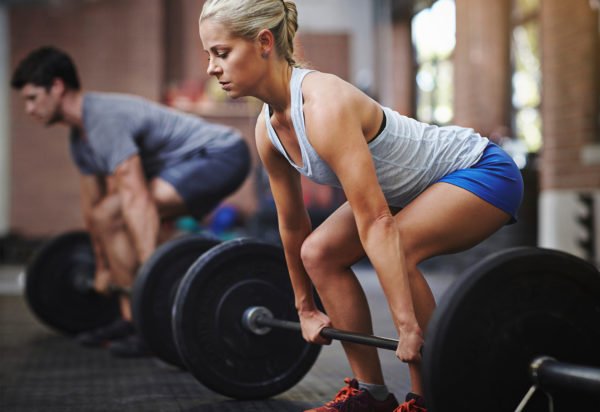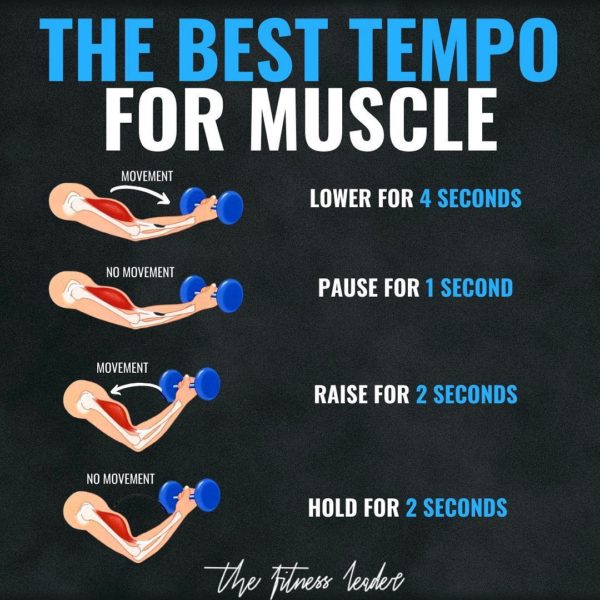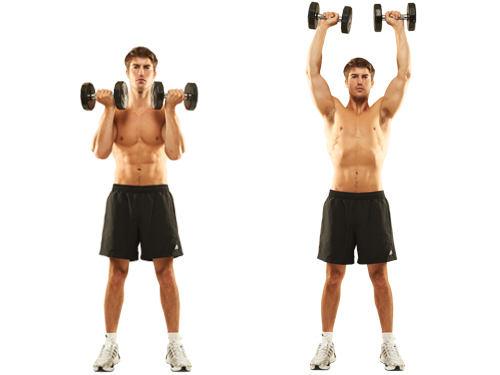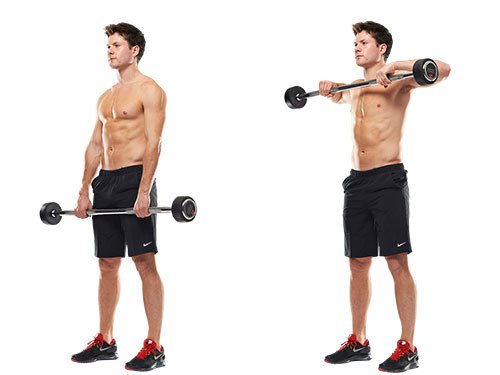The most common workouts are biceps, triceps and chest! Whilst training these areas, most people are under the illusion that it includes full shoulder training.
Although shoulders already get work as secondary muscles on chest and arm training, it is assumed singular training isn’t required. This is far from the truth.
There are a few people who have genetics that seem to grow no matter what they do, but for the majority, correct high-intensity shoulder training is required to ensure great development in this area.
A physique to look great and proportional will require well rounded shoulders to match the chest and arms.
You can also create the illusion of a V-taper look by developing your deltoids and losing a few inches off the waist.

Free Weights
To allow you to engage more muscles and strengthen your stabilising muscles, exercising with dumbbells and barbells are the perfect way. It is extremely important for an injury-free and highly effective performance to exercise overhead presses. This is great for building a strong and well-balanced body.
Free weights enable your body to move in all three planes of movement, this is how your body moves in daily life. This will help you increase your range of motion, target your muscles from all angles possible and build functional strength. Using free weights means you have to work to stabilise the weight while lifting it, meaning your overall stability will dramatically increase. Stability is important for the shoulder area, which is notorious for its vulnerability.
If you choose to use machines you find they allow you to focus more on the effort and less on the mechanics of the movements. This can be useful for the end of your workout, when accumulated fatigue makes balancing weights over your head very difficult.
It is more beneficial to do the harder, free weight variant of the exercise early in the workout before fatigue sets in. Save the machine version for when you can use it to cause maximum hypertrophy.
Also this will help to drain your muscles of any remaining strength by focusing on solely pushing the weight. Machines will allow you to lift heavier weights and isolate specific muscle groups. It is good to have a share of machine based movements in your routine alongside the free weights.
Make sure that free weight exercises are at the centre of your workout.

Time Under Tension
Shoulders can be one of the most reluctant body parts to grow. The reason for this is that these muscles are primarily for endurance rather than power.
The shoulders are used to working hard throughout the entire day to control all arm movements. This is why the most important thing to remember when training your shoulders, is that they need a lot of intensity in order to grow.
One way to do that is by using heavy weights, but that’s not always recommendable! Shoulder joints are very vulnerable to injury and your first priority should be keeping them healthy whilst improving the strength of the muscles surrounding them.
You can also enable optimal time under tension (TUT). Make sure to always perform the lowering part of your shoulder exercises in a slow and controlled manner, this is to maintain a good level of tension on the targeted muscle.
Try to make rest periods as short as possible and never go above 2 minutes. Keeping the intensity high will make your muscles work harder and prompt a greater growth. To completely exhaust the muscles and enable maximum hypertrophy, start your shoulder workouts with heavy presses and end them with a light weight isolation workout.

Introduce these 5 exercises into your shoulder routine:
1. Dumbbell Shoulder Press
This is a basic shoulder mass builder that allows you to target any existing muscle imbalances between your left and right side of the body when pressing. Your dominant side is probably stronger and compensates for the weaker side during barbell movements.
When pressing a barbell this is hardly noticeable, but with dumbbells you’ll be able to tell the difference straight away.
If you can, perform the exercise in front of a mirror so you can check your form, if not then take it slow and steady with a lighter weight, this is so you can feel the difference and adjust your form accordingly.

- Press the weight up in an explosive manner and push your head forward at the top of every rep.
- This is to make sure that you’re moving the load through your shoulders and not your chest muscles.
- Return the weight to the starting position with a slow and controlled movement.
- Perform 5 sets of 8-12 reps with 90 seconds rest in between.
2. The Arnold Press
This is a twisting variation of the standard shoulder press, this targets the front and side delts as well as the rotator cuff muscle group.
Many other muscles are involved in this exercise as secondary movers, which is why it works great for strengthening and stabilising the entire shoulder complex.
As you move the dumbbells higher overhead and begin to rotate the forearms, the upper arms shift out to the sides. This is engaging shoulder abduction which incorporates the lateral delts, whilst the triceps assist elbow extension.
The stabilisation of the scapula is achieved by activating the lower and middle portion of the traps to support the movement.

- To perform the Arnold press you need to hold the dumbbells at chest height, palms facing towards you, your elbows bent and keep your arms close to your torso.
- Move the weights up into the standard shoulder press position (weights at shoulder level), rotate the palms of your hands until they are facing forward and then drive the weight up without pausing until your arms are fully extended above you.
- Hold the peak contraction for a second, then slowly lower the weights back to the starting position and rotate the hands so that your palms are facing towards your body.
- Perform 4 sets of 8-12 reps with 90 seconds of rest in between.
3. Upright Barbell Row
The upright row is a very effective way to target your side delts and traps as prime movers. Making your front delts, rhombus and teres minor as secondary muscles. This compound exercise has to be performed with correct form to avoid injury.
Lifting the barbell too high on upright rows causes the shoulder blade to rub against the rotator cuff. This creates irritation and diminished range of motion, also known as shoulder impingement. This means that the exercise itself doesn’t destroy shoulders, but lack of maintaining proper form certainly does.
The same can be said for a long list of great mass builders. To prevent injury, all you have to do is keep the weight close to your hips and lift it only to the collar bones or top of the shoulders.

- To perform this, take a barbell or an EZ-bar and grip it with an overhand grip slightly narrower than shoulder width. Keep your back straight and maintain a slight bend in the elbows as the bar rests on the top of your thighs.
- Engage the sides of your shoulders to lift the bar, raising your elbows up and to the side. Keep the bar close to your body throughout the movement and make sure that your elbows are always higher than your forearms.
- Continue to lift the weight until it’s slightly below your chin and then lower it down in a controlled movement.
- Perform 5 sets of 8-12 reps with 90 seconds of rest in between.
4. The Lateral Raise
Controlling the lateral raise will help you develop your delts and build wider shoulders. This exercise strengthens your shoulders and increases your shoulder mobility.With any other movement, proper form is crucial to unlocking optimal gains.
Arms parallel will provide good overall deltoid support without placing the shoulder joints under too much stress. Whilst taking it 45 degrees past parallel you will fully activate the middle delts and also bring the upper traps, rhombus, lower traps and serratus into play.
You can incorporate both versions into your shoulder workouts by performing lateral raises to arms-parallel at the beginning, then adding a few above-parallel sets with lighter weights at the end of the workout.
In each variant, make sure to complete a full range of motion with each rep to get the most out of the exercise performed.

- Choose a relatively light set of dumbbells and hold them in front of your thighs with elbows slightly bent. Then bend over slightly at the hip and knees.
- Lift the weights up and out to the sides by abducting the shoulders until your elbows are at shoulder height. Squeeze the muscles hard and hold for one second, then lower the weights back to the starting position.
- Keep your elbows above or equal to the wrists all throughout the movement. When you are at the top of the movement, your elbows should be directly lateral to the shoulders.
- Perform 5 sets of 12 reps with 90 seconds of rest in between.
5. Barbell Or Dumbbell Shrugs
The shoulder shrug is a very beneficial isolation exercise for the traps.
Just because shrugs are technically an isolated movement, that doesn’t mean that their benefits are isolated to just the traps, shrugging also incorporates some back muscles.
When paired with poor posture, form and technique, the shrug is guaranteed to do more harm than good. This is why it is advised you perform shrugs of any kind if you intend to learn how to do it properly and always make sure it is performed with a flawless form.
If you can not, it is advised to do some safer shoulder moves until you are ready.
If you are ready then alternate between barbell and dumbbell shrugs with relatively heavy weights in order to provide your traps the optimal stimulation for growth.
The barbell shrugs allow you to use heavier weights, whilst the dumbbells offer a greater range of motion, so you should try both for best results.

- To finish the workout, perform dumbbell shrugs within a drop set. Pick a weight that’s heavy enough to make you struggle to complete one set of 15 good reps, then drop the weight by around 30% and complete another 15 reps without any rest in between.
- Reduce the weight again and immediately perform a third set of 15 reps, then rest for 90 seconds.
- Avoid rolling your shoulders forwards or backwards and try not to lift the weight using your triceps. At the top, raise your shoulders up as far as you can go and hold the peak contraction for a second.
- Perform 3 drop sets in total, with 15 reps on each intra set and 90-second rest in between drop sets.
Perform this workout once a week and you should be able to notice surprising results in your shoulder development.

